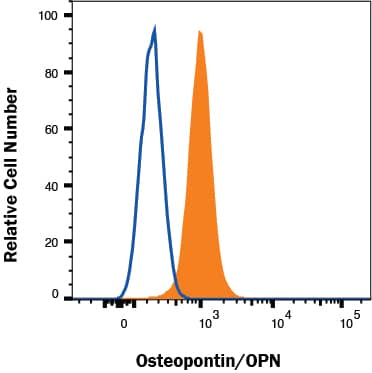Human Osteopontin/OPN APC-conjugated Antibody
R&D Systems, part of Bio-Techne | Catalog # IC14331A


Conjugate
Catalog #
Key Product Details
Species Reactivity
Human
Applications
Flow Cytometry
Label
Allophycocyanin (Excitation = 620-650 nm, Emission = 660-670 nm)
Antibody Source
Monoclonal Mouse IgG2A Clone # 223126
Product Specifications
Immunogen
Mouse myeloma cell line NS0-derived recombinant human Osteopontin
Ile17-Asn300
Accession # NP_000573.1
Ile17-Asn300
Accession # NP_000573.1
Specificity
Detects human Osteopontin in direct ELISAs and Western blots. In direct ELISAs and Western blots, this antibody does not cross‑react with recombinant mouse Osteopontin.
Clonality
Monoclonal
Host
Mouse
Isotype
IgG2A
Scientific Data Images for Human Osteopontin/OPN APC-conjugated Antibody
Detection of Osteopontin/OPN in U937 cells by Flow Cytometry
U937 cells were stained with Mouse Anti-Human Osteopontin/OPN APC-conjugated Monoclonal Antibody (Catalog # IC14331A, filled histogram) or isotype control antibody (Catalog # IC003A, open histogram). To facilitate intracellular staining, cells were fixed with Flow Cytometry Fixation Buffer (Catalog # FC004) and permeabilized with Flow Cytometry Permeabilization/Wash Buffer I (Catalog # FC005). View our protocol for Staining Intracellular Molecules.Applications for Human Osteopontin/OPN APC-conjugated Antibody
Application
Recommended Usage
Flow Cytometry
0.25 µg/106 cells
Sample: see below
Sample: see below
Formulation, Preparation, and Storage
Purification
Protein A or G purified from hybridoma culture supernatant
Formulation
Supplied in a saline solution containing BSA and Sodium Azide.
Shipping
The product is shipped with polar packs. Upon receipt, store it immediately at the temperature recommended below.
Stability & Storage
Protect from light. Do not freeze.
- 12 months from date of receipt, 2 to 8 °C as supplied.
Background: Osteopontin/OPN
References
- Ann. N.Y. Acad. Sci. (1995) 760, Apr. 21.
- Senger, D.R. et al. (1996) Biochim. Biophys. Acta. 1314:13.
- Agnihotri, R. et al. (2001) J. Biol. Chem. 276:28261.
Long Name
Secreted Phosphoprotein 1 [BNSP]
Alternate Names
Eta-1, OPN, Spp1
Gene Symbol
SPP1
UniProt
Additional Osteopontin/OPN Products
Product Documents for Human Osteopontin/OPN APC-conjugated Antibody
Product Specific Notices for Human Osteopontin/OPN APC-conjugated Antibody
For research use only
